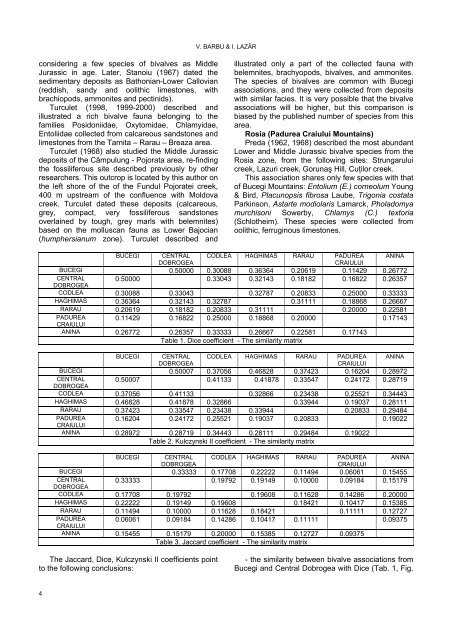statistical analysis of middle jurassic bivalve assemblages from
statistical analysis of middle jurassic bivalve assemblages from
statistical analysis of middle jurassic bivalve assemblages from
Create successful ePaper yourself
Turn your PDF publications into a flip-book with our unique Google optimized e-Paper software.
V. BARBU & I. LAZĂR<br />
considering a few species <strong>of</strong> <strong>bivalve</strong>s as Middle<br />
Jurassic in age. Later, Stanoiu (1967) dated the<br />
sedimentary deposits as Bathonian-Lower Callovian<br />
(reddish, sandy and oolithic limestones, with<br />
brachiopods, ammonites and pectinids).<br />
Turculet (1998, 1999-2000) described and<br />
illustrated a rich <strong>bivalve</strong> fauna belonging to the<br />
families Posidoniidae, Oxytomidae, Chlamyidae,<br />
Entoliidae collected <strong>from</strong> calcareous sandstones and<br />
limestones <strong>from</strong> the Tarnita – Rarau – Breaza area.<br />
Turculet (1968) also studied the Middle Jurassic<br />
deposits <strong>of</strong> the Câmpulung - Pojorata area, re-finding<br />
the fossiliferous site described previously by other<br />
researchers. This outcrop is located by this author on<br />
the left shore <strong>of</strong> the <strong>of</strong> the Fundul Pojoratei creek,<br />
400 m upstream <strong>of</strong> the confluence with Moldova<br />
creek. Turculet dated these deposits (calcareous,<br />
grey, compact, very fossiliferous sandstones<br />
overlained by tough, grey marls with belemnites)<br />
based on the molluscan fauna as Lower Bajocian<br />
(humphersianum zone). Turculet described and<br />
illustrated only a part <strong>of</strong> the collected fauna with<br />
belemnites, brachyopods, <strong>bivalve</strong>s, and ammonites.<br />
The species <strong>of</strong> <strong>bivalve</strong>s are common with Bucegi<br />
associations, and they were collected <strong>from</strong> deposits<br />
with similar facies. It is very possible that the <strong>bivalve</strong><br />
associations will be higher, but this comparison is<br />
biased by the published number <strong>of</strong> species <strong>from</strong> this<br />
area.<br />
Rosia (Padurea Craiului Mountains)<br />
Preda (1962, 1968) described the most abundant<br />
Lower and Middle Jurassic <strong>bivalve</strong> species <strong>from</strong> the<br />
Rosia zone, <strong>from</strong> the following sites: Strungarului<br />
creek, Lazuri creek, Gorunaş Hill, Cuţilor creek.<br />
This association shares only few species with that<br />
<strong>of</strong> Bucegi Mountains: Entolium (E.) corneolum Young<br />
& Bird, Placunopsis fibrosa Laube, Trigonia costata<br />
Parkinson, Astarte modiolaris Lamarck, Pholadomya<br />
murchisoni Sowerby, Chlamys (C.) textoria<br />
(Schlotheim). These species were collected <strong>from</strong><br />
oolithic, ferruginous limestones.<br />
BUCEGI CENTRAL CODLEA HAGHIMAS RARAU PADUREA ANINA<br />
DOBROGEA<br />
CRAIULUI<br />
BUCEGI 0.50000 0.30088 0.36364 0.20619 0.11429 0.26772<br />
CENTRAL 0.50000 0.33043 0.32143 0.18182 0.16822 0.26357<br />
DOBROGEA<br />
CODLEA 0.30088 0.33043 0.32787 0.20833 0.25000 0.33333<br />
HAGHIMAS 0.36364 0.32143 0.32787 0.31111 0.18868 0.26667<br />
RARAU 0.20619 0.18182 0.20833 0.31111 0.20000 0.22581<br />
PADUREA 0.11429 0.16822 0.25000 0.18868 0.20000 0.17143<br />
CRAIULUI<br />
ANINA 0.26772 0.26357 0.33333 0.26667 0.22581 0.17143<br />
Table 1. Dice coefficient - The similarity matrix<br />
BUCEGI CENTRAL CODLEA HAGHIMAS RARAU PADUREA ANINA<br />
DOBROGEA<br />
CRAIULUI<br />
BUCEGI 0.50007 0.37056 0.46828 0.37423 0.16204 0.28972<br />
CENTRAL 0.50007 0.41133 0.41878 0.33547 0.24172 0.28719<br />
DOBROGEA<br />
CODLEA 0.37056 0.41133 0.32866 0.23438 0.25521 0.34443<br />
HAGHIMAS 0.46828 0.41878 0.32866 0.33944 0.19037 0.28111<br />
RARAU 0.37423 0.33547 0.23438 0.33944 0.20833 0.29484<br />
PADUREA 0.16204 0.24172 0.25521 0.19037 0.20833 0.19022<br />
CRAIULUI<br />
ANINA 0.28972 0.28719 0.34443 0.28111 0.29484 0.19022<br />
Table 2. Kulczynski II coefficient - The similarity matrix<br />
BUCEGI CENTRAL CODLEA HAGHIMAS RARAU PADUREA ANINA<br />
DOBROGEA<br />
CRAIULUI<br />
BUCEGI 0.33333 0.17708 0.22222 0.11494 0.06061 0.15455<br />
CENTRAL 0.33333 0.19792 0.19149 0.10000 0.09184 0.15179<br />
DOBROGEA<br />
CODLEA 0.17708 0.19792 0.19608 0.11628 0.14286 0.20000<br />
HAGHIMAS 0.22222 0.19149 0.19608 0.18421 0.10417 0.15385<br />
RARAU 0.11494 0.10000 0.11628 0.18421 0.11111 0.12727<br />
PADUREA 0.06061 0.09184 0.14286 0.10417 0.11111 0.09375<br />
CRAIULUI<br />
ANINA 0.15455 0.15179 0.20000 0.15385 0.12727 0.09375<br />
Table 3. Jaccard coefficient - The similarity matrix<br />
The Jaccard, Dice, Kulczynski II coefficients point<br />
to the following conclusions:<br />
- the similarity between <strong>bivalve</strong> associations <strong>from</strong><br />
Bucegi and Central Dobrogea with Dice (Tab. 1, Fig.<br />
4
















